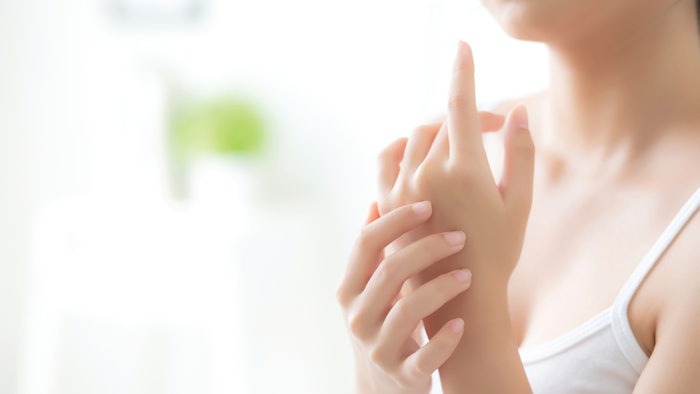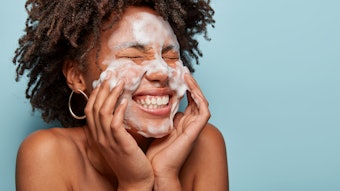
This article describes an approach to demonstrate the moisturizing efficacy of an upcycled postbiotic ferment using a novel digital imaging system that captures changes in the skin surface upon treatment.
Log in to view the full article
This article describes an approach to demonstrate the moisturizing efficacy of an upcycled postbiotic ferment using a novel digital imaging system that captures changes in the skin surface upon treatment.
Hydration has been a key cosmetics concern and core marketing benefit claim for decades. Especially now, hand skin dehydration is a common concern for many consumers using aggressive hygiene procedures. Responding to this need, a novel sustainable cosmetic ingredient for moisturizing skin care was developed by upcycling side streams from Lactobacillus probiotics manufacturing.
To test the ingredient's efficacy, however, the current researchers sought to evaluate moisturizing effects beyond the limits of stratum corneum water content measurements for a more holistic approach. Considering that skin surface changes that occur after a moisturizer is used—i.e., increased suppleness, decreased roughness, soothing sensations, lessened discomfort, etc.—are of high importance to user satisfaction, capturing reliable images of these changes occurring in skin and objectively quantifying skin surface parameters would bring interesting additional information to standard skin capacitance measurements.
Read the full article in the October edition of C&T magazine
Therefore, to investigate the moisturizing effects of the postbiotic ingredient, a combined approach was used in a case study of hand skin that included standardized corneometric measurements of the stratum corneum, and digital macro images captured and analyzed using a novel high quality camera developed to provide high resolution images, a three-dimensional (3D) reconstruction of the skin surface pattern, and objective parameters to follow up under the effect of a moisturizer.
The skin microrelief pattern consists of polygonal plateaus, mainly triangles or quadrangles, delineated by furrows.1-3 These furrows are classified according to their length and depth. Only the primary lines, i.e., the widest and the deepest (30-100 µm deep relative to the skin surface) are visible to the naked eye, while secondary lines are shallower (5-40 µm) and narrower. This topography would mainly relate to the 3D organization of the dermis and subcutaneous tissue, and would reflect the functional state of the skin.4-6 This pattern is clearly visible on the back of the hand skin and evolves with intrinsic (age, dryness, etc.) 7-8 and extrinsic factors (UV exposure, relative humidity, etc.).9-11
Microrelief pattern parameters previously were demonstrated to improve under the effect of moisturizers, compared using a similar approach to that described here in untreated forearm skin.12 Presented here are the results of such an investigation combined with corneometric measurements in a clinical study of hand skin. As will be shown, this approach provided added value for future clinical investigations.
Furthermore, the development of a reliable scientific tool for visualization is important to claims substantiation and the accurate reading and interpretation of complex results. As such, the findings from the moisturization assessments were projected in a model using a method of continuous color mapping, which helped to objectively display differences between the test ingredient and the placebo...
Read the full article in the October edition of C&T magazine
References
- Hashimoto, K. (1974). New methods for surface ultrastructure: Comparative studies of scanning electron microscopy, transmission electron microscopy and replica method. Int J Dermatol 13 357-381.
- Piérard-Franchimont, C. and Piérard, G.E. (1987). Assessment of aging and actinic damages by cyanoacrylate skin surface strippings. Am J Dermatopathol 9(6) 500-509.
- Quatresooz, P., Thirion, L., Piérard-Franchimont, C. and Piérard, G.E. (2006). The riddle of genuine skin microrelief and wrinkles. Int J Cosmet Sci 28(6) 389-395.
- Piérard, G.E., Franchimont, C. and Lapierre, C.M. (1980). Le vieillissement, son expression au niveau de la microanatomie et des propriétés physiques de la peau. Int J Cosmet Sci 2(4) 209-214.
- Stamatas, G.N., Nikolovski, J., Luedtke, M.A., Kollias, N. and Wiegand, B.C. (2010). Infant skin microstructure assessed in vivo differs from adult skin in organization and at the cellular level. Pediatr Dermatol 27(2) 125-131.
- Fischer, T.W., Wigger-Alberti, W. and Elsner, P. (1999). Direct and non-direct measurement techniques for analysis of skin surface topography. Skin Pharmacol Appl Skin Physiol 12(1-2) 1-11.
- Corcuff, P., de Rigal, J., Lévêque, J.L., Makki, S. and Agache, P. (1983). Skin relief and ageing. J Soc Cosmet Sci 34 177-190.
- Vörös, E., Robert, C., Godeau, G. and Robert, A.M. (1989). Morphometric study of the evolution of the skin surface relief with age. Acta Stereo 8 379-380.
- Corcuff, P., Francois, A.M., Lévêque, J.L. and Porte, G. (1988). Microrelief changes in chronically sun-exposed human skin. Photodermatol Photoimmunol Photomed; 5 92-95 32/43 19.
- De Paepe, K., Lagarde, J.M., Gall, Y., Roseeuw, D. and Rogiers, V. (2000). Microrelief of the skin using a light transmission method. Arch Dermatol Res 292 500- 510.
- Egawa, M., Oguri, M., Kuwahara, T. and Takahashi, M. (2002). Effect of exposure of human skin to a dry environment. Skin Res Technol 8 212-218.
- Gougeon, S., Hernandez, E., Chevrot, N., Vergne, T., Cherel, M., Prestat-Marquis, E., Jomier, M. and Burty-Valin, E. (2022). Evaluation of a new connected portable camera for the analysis of skin microrelief and the assessment of the effect of skin moisturizers. Skin Res Technol [accepted]










